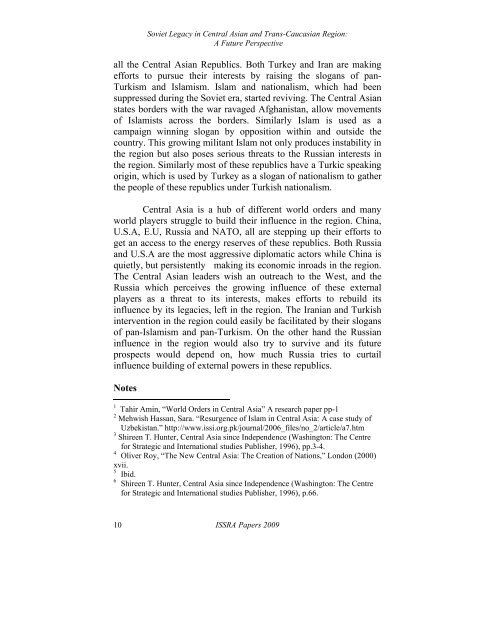issra papers vol i, 2009 - National Defence University
issra papers vol i, 2009 - National Defence University
issra papers vol i, 2009 - National Defence University
You also want an ePaper? Increase the reach of your titles
YUMPU automatically turns print PDFs into web optimized ePapers that Google loves.
Soviet Legacy in Central Asian and Trans-Caucasian Region:<br />
A Future Perspective<br />
all the Central Asian Republics. Both Turkey and Iran are making<br />
efforts to pursue their interests by raising the slogans of pan-<br />
Turkism and Islamism. Islam and nationalism, which had been<br />
suppressed during the Soviet era, started reviving. The Central Asian<br />
states borders with the war ravaged Afghanistan, allow movements<br />
of Islamists across the borders. Similarly Islam is used as a<br />
campaign winning slogan by opposition within and outside the<br />
country. This growing militant Islam not only produces instability in<br />
the region but also poses serious threats to the Russian interests in<br />
the region. Similarly most of these republics have a Turkic speaking<br />
origin, which is used by Turkey as a slogan of nationalism to gather<br />
the people of these republics under Turkish nationalism.<br />
Central Asia is a hub of different world orders and many<br />
world players struggle to build their influence in the region. China,<br />
U.S.A, E.U, Russia and NATO, all are stepping up their efforts to<br />
get an access to the energy reserves of these republics. Both Russia<br />
and U.S.A are the most aggressive diplomatic actors while China is<br />
quietly, but persistently making its economic inroads in the region.<br />
The Central Asian leaders wish an outreach to the West, and the<br />
Russia which perceives the growing influence of these external<br />
players as a threat to its interests, makes efforts to rebuild its<br />
influence by its legacies, left in the region. The Iranian and Turkish<br />
intervention in the region could easily be facilitated by their slogans<br />
of pan-Islamism and pan-Turkism. On the other hand the Russian<br />
influence in the region would also try to survive and its future<br />
prospects would depend on, how much Russia tries to curtail<br />
influence building of external powers in these republics.<br />
Notes<br />
1 Tahir Amin, “World Orders in Central Asia” A research paper pp-1<br />
2 Mehwish Hassan, Sara. “Resurgence of Islam in Central Asia: A case study of<br />
Uzbekistan.” http://www.issi.org.pk/journal/2006_files/no_2/article/a7.htm<br />
3 Shireen T. Hunter, Central Asia since Independence (Washington: The Centre<br />
for Strategic and International studies Publisher, 1996), pp.3-4.<br />
4 Oliver Roy, “The New Central Asia: The Creation of Nations,” London (2000)<br />
xvii.<br />
5 Ibid.<br />
6 Shireen T. Hunter, Central Asia since Independence (Washington: The Centre<br />
for Strategic and International studies Publisher, 1996), p.66.<br />
10<br />
ISSRA Papers <strong>2009</strong>

















